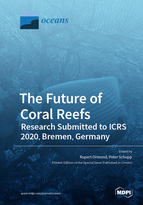The Future of Coral Reefs: Research Submitted to ICRS 2020, Bremen, Germany
A special issue of Oceans (ISSN 2673-1924).
Deadline for manuscript submissions: closed (30 April 2021) | Viewed by 76485
Special Issue Editors
Interests: coral reefs; reef fish; sharks; reef fisheries; corals; marine conservation; marine protected areas
Special Issues, Collections and Topics in MDPI journals
2. Helmholtz Institute for Functional Marine Biodiversity at the University of Oldenburg (HIFMB), Ammerländer Heerstrasse 231, 26129 Oldenburg, Germany
Interests: coral reproduction and restoration; phase shifts in benthic communities; coral and sponge microbial symbiosis
Special Issues, Collections and Topics in MDPI journals
Special Issue Information
Dear Colleagues,
Prior to the postponement of the 14th International Coral Reef Symposium (ICRS 2020, https://www.icrs2020.de/), due to be held in Bremen, Germany, arrangements had been made with the journal OCEANS to produce a conference Special Issue, to which conference delegates could submit papers based on their presentations or posters.
While the conference itself has now been postponed until 2021, the organizers (chaired by Professor Christian Wild) and OCEANS have agreed to continue with the publication of a Special Issue in 2020. This is to provide intending delegates who wish with an appropriate outlet for material that they had expected to publish this year. Suitable manuscripts will be published on-line as they are received and approved, thus ensuring publication in 2020 of manuscripts that are received in good time.
The Special Issue will retain the planned name (i.e. “The Future of Coral Reefs: Research Submitted to ICRS 2020”) and continue to reflect the conference themes. In addition, it is anticipated that a sister (Part II) issue will be published soon before the ICRS 2021 virtual, linked to the virtual and actual conference event.
Instructions on how to submit to OCEANS may be found at https://0-www-mdpi-com.brum.beds.ac.uk/journal/oceans/instructions. All submissions will be subject to standard reviewing procedures to ensure reasonable standards of writing and accuracy. OCEANS has no restrictions on the length of manuscripts and hence, short papers based on either conference presentations or posters will be considered.
Given delays in holding the Conference, the deadline for submission of abstracts for the this Special Issue has been extended to April 30th, 2021. Authors wishing to submit a manuscript to this issue are asked to notify the coordinating editor, Prof. Dr. Rupert Ormond ([email protected]) as soon as practicable, mentioning their conference abstract reference number.
Authors whose first language is not English are encouraged to submit manuscripts, but it is recommended that they have their text checked by a native English speaker or make use of MDPI’s English editing Service (https://0-www-mdpi-com.brum.beds.ac.uk/authors/english).
Sincerely,
Prof. Dr. Rupert OrmondProf. Dr. Peter Schupp
Guest Editors
Manuscript Submission Information
Manuscripts should be submitted online at www.mdpi.com by registering and logging in to this website. Once you are registered, click here to go to the submission form. Manuscripts can be submitted until the deadline. All papers will be peer-reviewed. Accepted papers will be published continuously in the journal (as soon as accepted) and will be listed together on the special issue website. Research articles, review articles as well as short communications are invited. For planned papers, a title and short abstract (about 100 words) can be sent to the Editorial Office for announcement on this website.
Submitted manuscripts should not have been published previously, nor be under consideration for publication elsewhere (except conference proceedings papers). All manuscripts are thoroughly refereed through a single-blind peer-review process. A guide for authors and other relevant information for submission of manuscripts is available on the Instructions for Authors page. Oceans is an international peer-reviewed open access quarterly journal published by MDPI.
Please visit the Instructions for Authors page before submitting a manuscript. The Article Processing Charge (APC) for publication in this open access journal is 1000 CHF (Swiss Francs). For published papers prepared for ICRS 2020, the APC will be fully subsidized by MDPI. Submitted papers should be well formatted and use good English. Authors may use MDPI's English editing service prior to publication or during author revisions.







